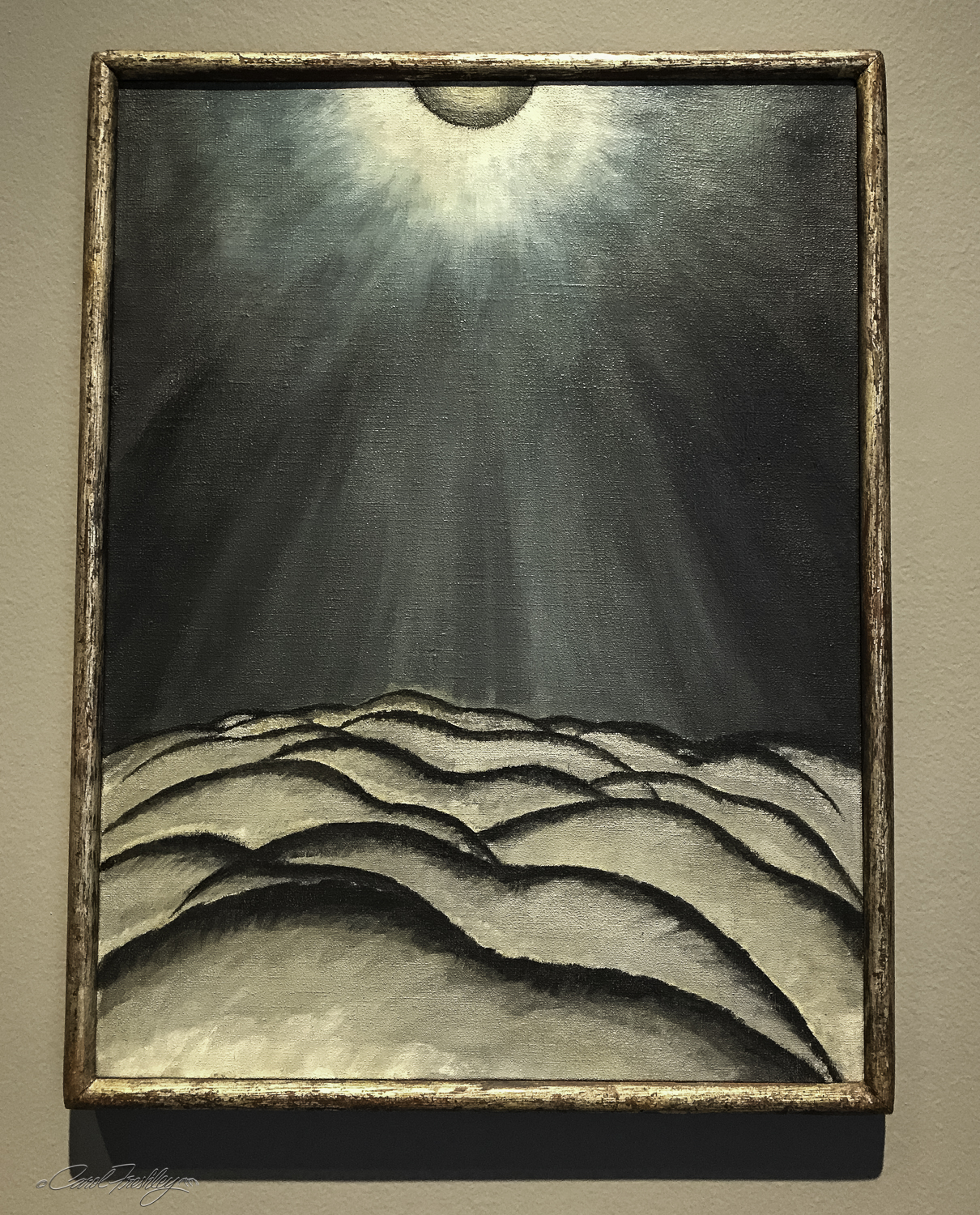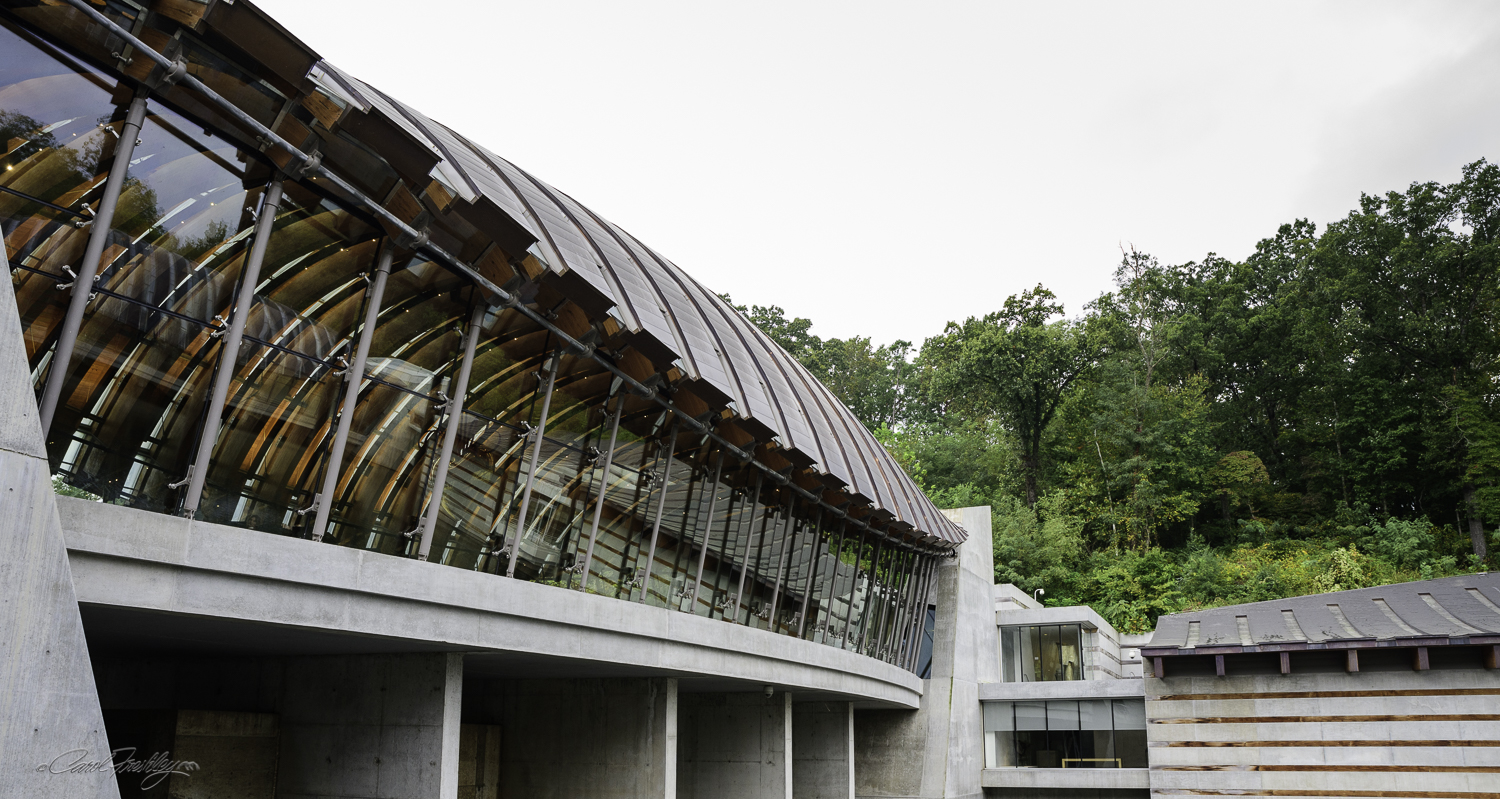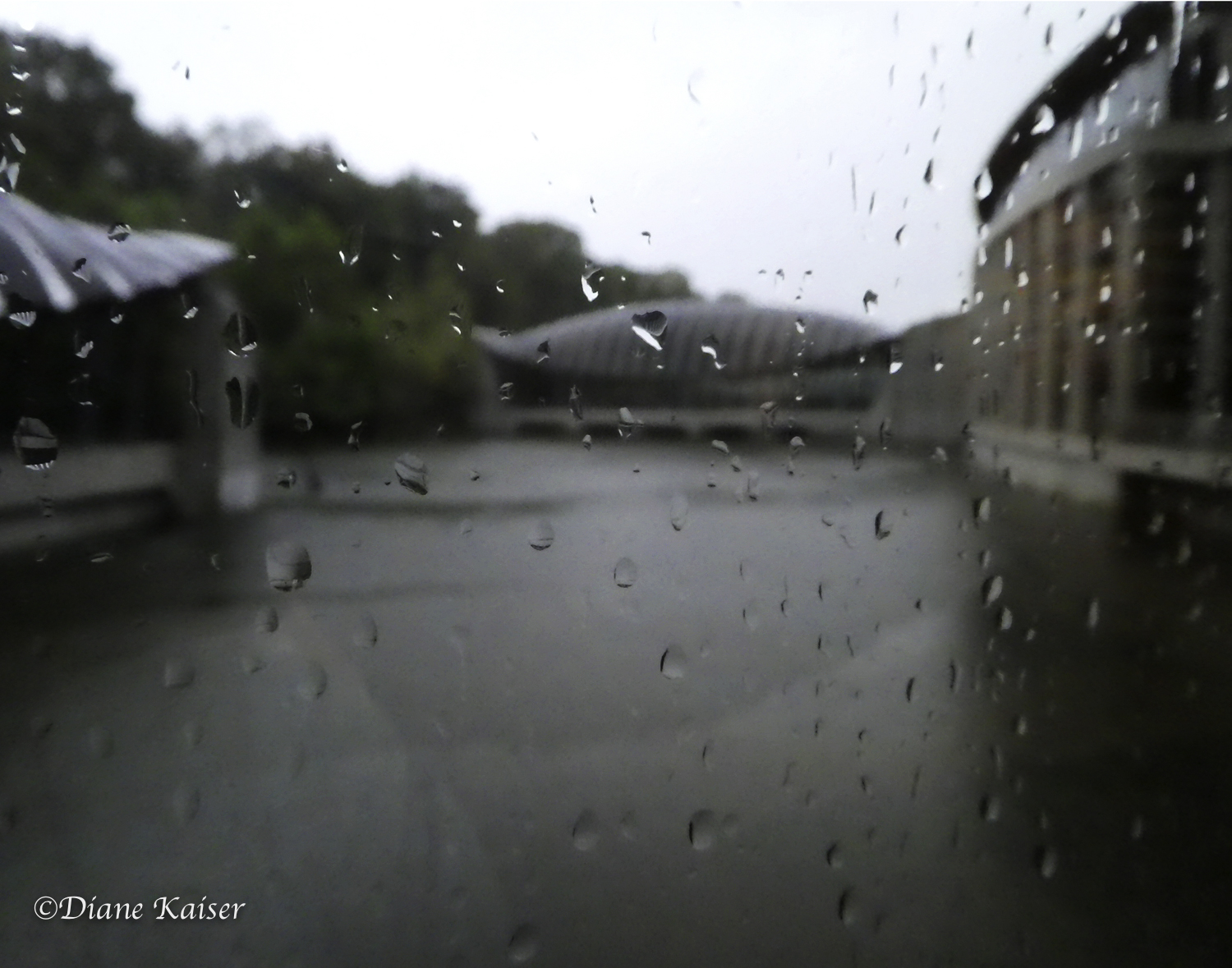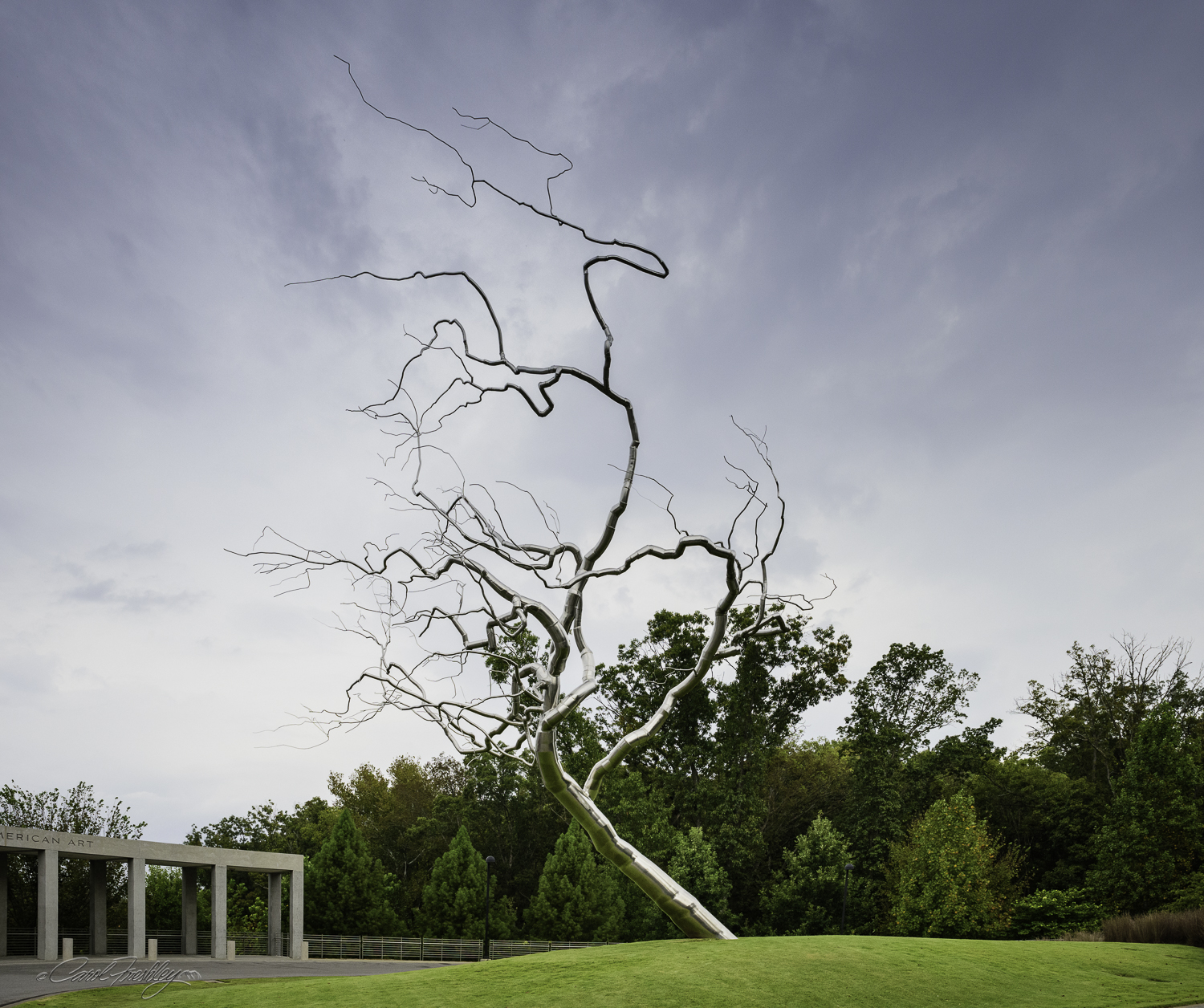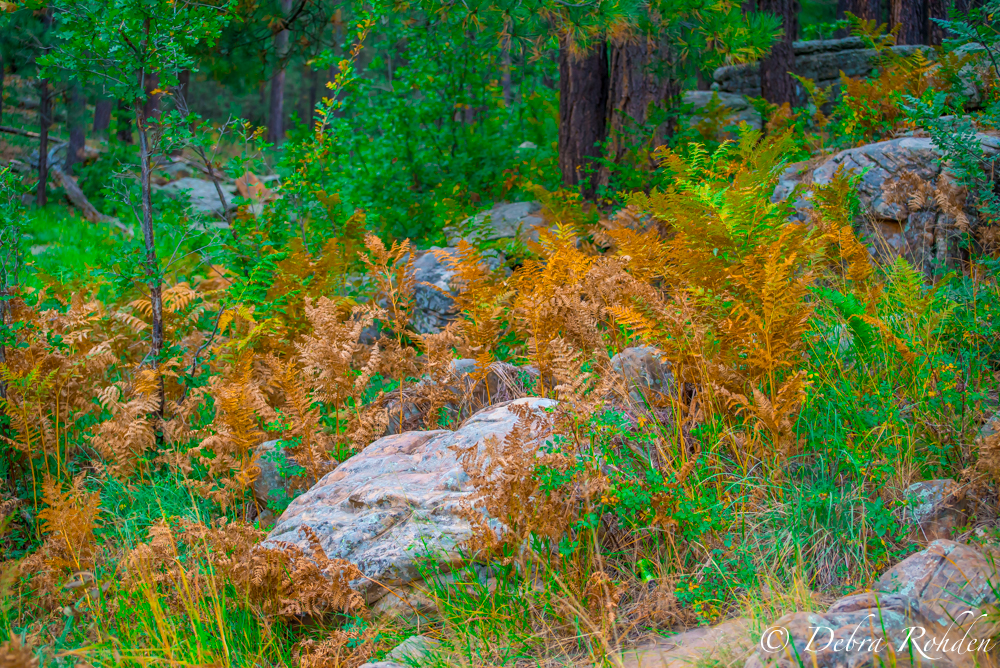The outside and grounds of Crystal Bridges Museum of American Art are worth a trip all of its own. Go inside and it is just icing on the cake. Lots of icing! Rich creamy icing!! The space is open, light and easy to maneuver. There is a wonderful restaurant with a brunch served on Sundays (table cloth included). There are well placed sculptures, special exhibits and places to rest. At this time the special art exhibit is a good representation of the work of Stuart Davis. Our photographs of the paintings could be boring, however, for some it will provide a sense of the place. Photographers are welcome at the Museum but tripods are not encouraged, except outdoors. The use of flash is prohibited (as usual in museums). We hope you enjoy your visit to the Museum.
Section of the Museum devoted to the Stuart Davis Exhibition.
This mobile by Alexander Calder (1898-1976) is a classic example of Calder's standing mobiles. Made of painted sheet metal, Trois noirs sur un rouge (Three Blacks over Red), 1968, achieves graceful balance in motion. Calder, ''challenged the traditional definition of sculpture as three-dimensional mass, creating works of art made from metal rods and biomorphic sheet metal planes that move with the air in varied and spontaneous paths."
This painting, Pecos Escarpment, is an egg tempera on cradled panel by Alexandre Hogue (1898-1994).
This is a painting by George Copeland Ault (1891-1948). It is an oil on canvas. The information on the side tells the viewer, "Daylight at Russel's Corners expresses the melancholy and anxiety felt my many Americans following the Great Depression, which was further amplified by the Second World War. The precise line and geometry in this work convey a sense of order. The phone lines, frosted in ice, are the only connection to the outside world - potentially delivering chilling news from the war. The quietness of the scene, coupled with the precise, hard-edge style, helps to make this image feel frozen in time."
This Lobster Wars, by Bo Bartlett (1955-) is an oil on linen depicting the sometimes violent conflicts that arise between lobster fishermen who have, for generations, squabbled over fishing territories. His allusions to pirates and Vikings link these present-day sea farmers to historically fierce warriors of the high seas.
This is an untitled piece made of bronze wire by Ruth Asawa (1926-2013). The side description states: "At the center of the circular shape, a knot of wrapped wires extends outward, eventually unraveling into spikey forms that look similar to tree branches. As a child during World War II, Ruth Asawa was interned at Rohwer War Relocation Center in Desha County, Arkansas. Much of her artwork was influenced by this imprisonment and marginalization. Untitled, with its organic appearance, nod to the fencing that surrounded the internment camp, giving the lovely object a subtle sinister edge."
Evan Penny, born in 1953, uses silicone, pigment, hair, fabric and aluminum to create Old Self: Portrait of the Artist as He Will (Not) Be. Variation #2. "Larger than life-size and hauntingly realistic, Evan Penny's self-portrait marries traditional sculpting processing with cutting-edge technology. using a 3-D scanner, Penny made digital scans of his body, created clay form based on the scans, and then manipulated these clay forms by hand. He cast the clay version in resin before adding pigment and other elements - such as his own hair - to the sculpture's silicone surface. In this work, Penny attempts to transform the fleeting moment captured by photography into three dimensions. The artist suggests that we imagine ourselves through the lens of photography, even though we live our lives in three dimensional space. . . he reimagines himself as an elderly man. By making himself look decades older, he created a self-portrait that manages to be both realistic and make-believe."
As mentioned earlier, there were lots of places to sit and rest.
We had way too much fun!!
Andy Warhol (1928-1987) Self-Portrait with Camouflage made of silkscreen inks and synthetic polymar on canvas.
Another Untitled by Ruth Asawa, this time made of iron wire. The cage-like organic shape binds and encloses smaller forms within the larger composition. The negative space between the wires creates volume. The sculpture evokes fencing materials surrounding internment camps. Diane and I spent some time seeking a perfect balance of the cages and their shadows.
I loved this painting! It was done by Arthur Dove (1880-1946) and is titled, Moon and Sea No. II. Dove describes the storm he was hoping to express, "It is now 3:45 a.m. in the midst of a terrific gale and we are anchored in the middle of Manhasset Bay, held by a 3/4 inch line run through a shackle to a mooring. Have been trying to memorize this storm all day so I can paint it. Storm green and storm gray." Dove is considered America's first abstract painter, striving to make the basic processes of nature visible in his work.
Reflections of the ceiling ribs on the windows of the restaurant were intriguing. I tried to figure out how they were created and then painted the landscape outdoors. Lunch was excellent!
This is Harriet Whitney Frishmuth's (1880-1980) The Bubble, made of bronze and glass in 1928.
Mary Ann Currier painted this oil pastel on board entitled Carolina Apples. She is known for using commonplace subjects in her contemporary still lifes. In this painting she emphasizes the fleeting nature of existence by picturing music, food and other transient and sensual experiences. The artist was born in 1927. The painting was done in 1985.
Abstraction, by Georgia O'Keefe (1887-1986). It is made of white-lacquered bronze.
George Segal (1924-2000) sculpted these figures with plaster. They represent the Americans waiting in line for public assistance during the Great Depression. The title, Depression Bread Line, suits the intent of evoking the emotional tenor of how it felt to live during this time. A bronze cast of this original sculpture marks the Roosevelt Memorial in Washington, D.C.
We could not leave well enough alone. We suggested that Tom stand at the end of the line.
Tom created an image that adds him to the 5 men in line. Nicely done considering he did not have an old trench coat. There is one other subtle difference that I noticed. Tom is at the end of the line and it is his first time there. He is not quite as beaten down and discouraged as the other men. He is the optimist in line that he is every day. His shoulders are straight and his head held high.
This was shown at the start of the special Stuart Davis exhibition. I really enjoyed the collection of about 150 or so paintings. I could back again and walk the area several more times.
Electric Bulb, by Stuart Davis (1892-1964). Davis was very interested in modern European art and spent decades investigating the many ways that French artists, in particular, simplified their compositions. Here the artist used a modern item, for its time, and its protective wrapper to create a bouncy, almost cartoon-like image that is pushing the definition of abstraction. It was noted that in 1924, the date this painting was created, 30% of American homes still did not have electricity.
We hope you have enjoyed your tour. If you have a chance and are in the area, spend a day at this museum. Admission is free.



















